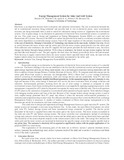Energy Management System for Solar And Grid System

View/
Date
2021-11Author
Masika, J. W.
Muriithi, Christopher M.
Apiyo, E. O.
Mbura, C. M.
Mwanza, S. K.
Metadata
Show full item recordAbstract
Electricity is an important resource both in domestic and industrial environment. The rise in electricity demand has led to conventional resources being exhausted and possibly lead to rise in electricity prices. since conventional resources are being exhausted, there is need to search for alternative energy sources to supplement the conventional sources. Use of green energy as an alternative to generation of electricity from conventional sources is currently on the rise. This study aims to design and implement an Energy Management System (EMS) in a grid-tied solar Photovoltaic (PV) system. The aim of this EMS is to reduce the grid electricity need to an ordinary consumer in Kenya and create dependency on renewable energy sources. One of the major expenses of the ordinary consumer in Kenya is the cost of electricity. Murang'a University of Technology was chosen as the case study. Arduino Uno chosen to switch between the micro sources and the utility grid with the micro sources given priority over the utility grid. With sufficient solar irradiation, the solar PV supplies the load power provided the load demand is met, the excess charges the battery through charge controller. With a drop in irradiance, the battery storage system supplies the load provided the load demand is met. The grid supplies the load when the battery power drops below the load demand. With the drop in supply current drawn from the micro sources below specified thresh hold value, the load with the highest current rating was disconnected first and immediately reconnected to the utility grid.
